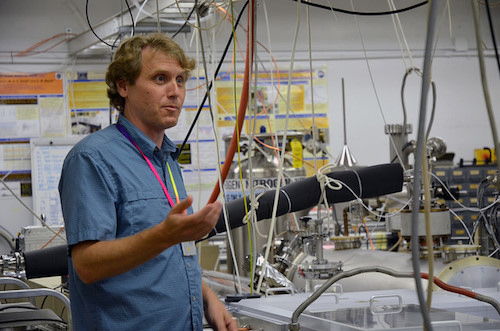Teachers Can’t Fix the STEM Problem Alone
 When Ryan Lytle wrote his US News article “Teachers Are Key to Building STEM Brand” several years ago, he reported that even with an increased focus on STEM, not enough students were pursuing STEM careers to stop the bleeding in business and industry. The “experts” he quoted (including the CEO of a brand management agency) focused on teachers as the ones who needed to step into that gap and build the bridge that solves the problem.
When Ryan Lytle wrote his US News article “Teachers Are Key to Building STEM Brand” several years ago, he reported that even with an increased focus on STEM, not enough students were pursuing STEM careers to stop the bleeding in business and industry. The “experts” he quoted (including the CEO of a brand management agency) focused on teachers as the ones who needed to step into that gap and build the bridge that solves the problem.
The shortage of STEM-focused graduates hasn’t gone away, and neither has the easy solution: “Let the teachers fix it.” Are we surprised? When new needs such as STEM arise, even on a national scale, the action plan generally lands on (1) widely publicizing the need; (2) asking businesses to join the effort, and (3) soliciting departments of education and school systems to get involved.
Then at some point down the line teachers get the abrupt memo: “Fix it.”
Translated from high level command-speak to school level reality, “fix it” means something like the following:
► Learn all about the STEM issue, get the new knowledge you need, add new teaching techniques to your repertoire ASAP, teach STEM classes, get your students to a high level of STEM learning, and motivate them to enter STEM careers.
► Oh yes, and don’t forget to continue to focus intently on getting those test scores up on the state test; help with extracurricular activities; do the usual required record-keeping, housekeeping chores, and administrative tasks; enforce school regulations; prepare regular reports on student discipline issues, etc.; and distribute and collect textbooks for all of your students.
► And, of course, supervise students in halls, the lunchroom, field trips, the school ground, and other school functions. Meet regularly with your department members; meet with parents; collect and receipt money for fundraisers, and attend faculty meetings for further updates on what you need to help with.
Don’t forget bus duty and thank you for your willingness to invest your unencumbered time becoming a leader in this new STEM initiative.
Let’s take a closer look at this scenario
I’m wondering if a little realism is in order here.
I became a teacher (leaving a more lucrative career) because I deeply believe in the value of teaching and the important role teachers play in this nation. Our schools are the only places in this nation that children of all ethnicities and socioeconomic levels come together to learn and prepare for our future together as one nation.
When our schools don’t function well, our nation doesn’t function well. And the key to high functioning schools is high-functioning teachers.
What do teachers need?
So what do our teachers need in order to be high-functioning STEM teachers? I’m going to skip some really obvious solutions such as reinventing how we do school and what the roles of teachers within those schools should include. (For more on that, follow @teachingquality or more specifically, this story about a PA district.)
Let’s just pretend that everything is set up to allow teachers to focus on only student learning from the time they walk in the door to the time they leave. In that best-case scenario, what would be required of a teacher to successfully lead STEM classes?
Here are my thoughts . . .
- STEM primarily targets science and math teachers – and technology teachers if the school has these. STEM requires these teachers to become at least somewhat proficient in both grade-level science and grade-level math in order to integrate these into STEM lessons.
- STEM teachers need to be knowledgeable and comfortable with a variety of technologies and their uses.
- STEM teachers require actual STEM lessons. Much of what’s out there now isn’t integrated STEM – it’s a science, math, or technology lesson packaged as “kinda STEM.” Much of it doesn’t use an engineering design process. Since few real STEM lessons are available, STEM teachers often must find time, knowledge, and energy to design their own lessons.
- STEM teachers require additional resources and materials, including dependable access to technology for their students during class.
The 2 top needs of STEM teachers
The previous needs are basic requirements. These two are also essential:

► Teachers require time. STEM requires teachers to acquire new techniques for teaching while they are currently teaching. (Ever heard of building the airplane while you’re flying it?) They must examine science, math, and technology through an engineering lens. They need time to meet together, plan together, learn together, develop and field-test STEM lessons together, and redesign these lessons until their students successfully achieve the needed outcomes.
No business would dream of adding a new important initiative and provide less than adequate preparation for its workers. To do so would probably guarantee disaster. This applies to schools as well, and STEM is an important educational enterprise.
It’s not simply a technology fix
In the US News article, one expert suggested that teachers should help the STEM initiative by immersing themselves in new technologies and helping students to become more technologically savvy. Notwithstanding the fact that helping students learn technology is not teaching STEM (notice the other three letters in the acronym?), I know most teachers would gladly do that. So when? How? And how much just-in-time support will they have access to as they practice using these technologies in their classes?

STEM teacher recruitment is complicated
The presenters at the US News STEM Solutions Summit also suggested that teachers should encourage other teachers to get involved in STEM education, and alleviate fears that STEM is a difficult set of topics to teach. (Set of topics? Hopefully that doesn’t mean science, math, and technology as separate subjects. We have that silo scenario already. When you think of K-12 STEM, think integrated STEM.)
I agree with the speakers that STEM teachers can be advocates and resources as an effort is made to recruit other teachers – IF we make teaching STEM an exciting, doable experience for well-prepared and well-equipped educators.
That means someone must take the responsibility for setting up situations and opportunities that allow teachers to gain the information, opportunities, and time to become well-prepared and well-equipped. Believe me, the majority of teachers are more than willing to succeed at being STEM teachers. Let’s give them the chance.
If you know of examples where these issues are being addressed, PLEASE share them here in the comments and let’s talk more about what it will take to produce the STEM educators we desperately need to make the national STEM initiative work.





































Anne – What a wonderful article! I’m a retired manufacturer very familiar with the STEM “Skills Gap” at the industry level. As I started to work with my local school districts in NH I came to realize just what you have so perfectly identified in your posting. Teachers are ALREADY buried especially with the advent of Common Core and the new standardized testing. And yet they have become the “Firewall” for STEM.
I’m not a big fan of “recreating the wheel”. I like to look for available tried and proven solutions to problems before I invest in creating my own program from scratch. One good proven STEM option I’ve come across is “Project Lead the Way”. https://www.pltw.org/
Thank YOU for your wonderful BLOG and resources!
Thanks for the positive response. I’m glad to know that folks from industry are actively working with STEM initiatives – it adds a lot of reality to the initiative. In Mobile, AL where I did most of my STEM work, business and industry volunteers would join in a day of STEM lessons, help with activities, and provide support for teachers and students. They would also sit down at the table with teachers and curriculum writers and help to design the lessons needed for our kids in that area. It was a marvelous partnership!
I’m glad the PLTW curriculum is working for you. I have worked with some folks who have used that curriculum and they feel it’s on target. That’s good news, and I hope it continues to help your NH school districts! Thanks for sharing that resource.
Anne,
Great points.
Districts and communities seeking STEM education solutions need to commit to investing in STEM from defining their goals and expectations, to re-thinking the learning environment and roles of educator and learner, to providing on-going professional development and technical support.
The comment above provides the link to PLW, a valuable solution for some communities. I’d like to also refer readers to SmartLabs by Creative Learning Systems. [Full disclosure, I’m with CLS].
Learn more about our STEM education solution here:
http://www.creativelearningsystems.com/default.aspx